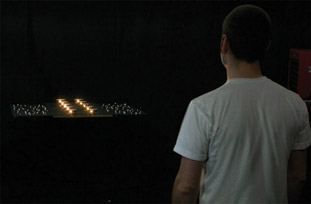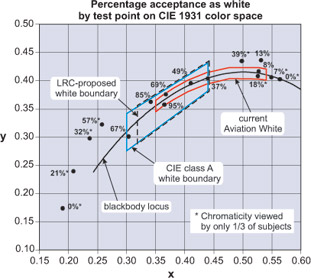|

Redefining White Light Chromaticity Boundaries for Aviation

A subject observes the simulated test pattern during Phase II of the project.

Percentage acceptance as white for Phase II (in-context) test points. The blackbody locus, current aviation white boundary, and CIE Class A white boundary are shown for reference, along with the LRC's proposed boundary.
|
Several aspects are involved in the recognition of an aviation signal light’s color, including its chromaticity, layout on the airfield, and the chromaticity of other light sources in view. Current chromaticity standards for “aviation white” were established in the 1960s and based on incandescent light sources. The existing boundary for aviation white excludes certain color bins of white LEDs. Only a small subset of commercially available white LEDs meet the current chromaticity requirements for aviation white, making it difficult to adopt this energy-efficient technology for airfields.
The LRC conducted a human factors investigation of the boundaries in chromaticity space that people perceive as white and recommended new aviation white boundaries that were independent of the color limitations of incandescent sources.
EXPERIMENT
In Phase I experiments, researchers sought to identify a “region of interest” on the CIE 1931 chromaticity diagram by presenting color samples from a large area in and around the current aviation white region. The results were used to predict patterns of chromaticity acceptance as “white.” Subjects viewed precise color samples, but their context was not representative of what a pilot would experience.
In Phase II, researchers investigated the acceptability of chromaticity points identified in Phase I using phosphor-converted LED sources and color filters to produce the samples—arranged along a simulated, scaled-down, airport runway. The size, orientation, and intensity of the samples were representative of how a pilot would observe them.
RESULTS
This research, along with previous studies, indicated that the current color boundary of aviation white extends too far toward the “yellow” region. On the other side, the blue boundary of aviation white may be too conservative. Based on the results of this study, the CIE’s recommendations, and the available literature, the LRC recommended:
- The yellow boundary of aviation white should be moved to x = 0.440 (from x = 0.540). This change would help limit confusion between white and yellow signal colors.
- The blue boundary of aviation white should be moved to x = 0.320 (from x = 0.350). This would allow some relatively high CCT LED sources to be used (up to 6000 K).
- The boundaries in the y-direction should be expanded to fully cover the white LED chromaticity bins specified by ANSI C78.377.
Before implementing any changes, however, a field validation study should be conducted.
PUBLICATIONS
Project Summary Sheet 
Project Poster 
SPONSOR
Federal Aviation Administration
(Cooperative Agreement FAA/05-C-AT-RPI Amendment 11)
|


